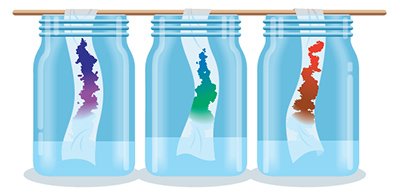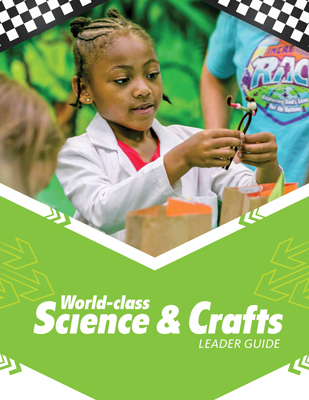Spot the Color
Day Three Experiment
on August 1, 2019Discover Pigments That Make Up Colors

Materials (per group)
- 2 coffee filters
- Child-safety scissors
- Washable dark-colored felt-tip markers (black, brown, green, blue)
- Blender
- A variety of green leaves, separated by type: maple, oak, spinach, kale (enough of each type to make 1/4 c. of each when blended); see directions for other options
- Isopropyl alcohol (adults only)
- Clear glass cups or jars, 1 for each leaf and marker
- Straw, 1 for each leaf or marker
- Tape
- Babel Legend cards (download below), 1 per child
Pre-prep
Cut the coffee filters into strips that are 1 inch wide and at least 5 inches long. Or you can allow the children to cut the strips and place the dot on the strips during class.
Class Time Directions
Start the experiment first and then proceed with the explanation and discussion. Only adults should operate the blender. Use care with the glass cups or jars.
Markers: Place one dot from the black marker 1 inch from the bottom of a coffee filter strip. Do the same for the other markers. Tape the top of each strip to a straw. Suspend the straw over the top of the cup and then pour water into the cup (avoiding the filter) so that the bottom of the coffee filter is in the water but the water isn’t touching the dot. Watch as the pigments separate as the water migrates up the coffee filter.
Leaves: Blend each type of leaf separately. Pour each leaf juice into a clear cup and cover the juice with isopropyl alcohol. Label the cups so that you know which leaf is in the cup. Allow the mixture to soak for a while. Tape the top of a coffee filter to a straw and suspend the straw over the lip of the cup so that the filter hangs down. Adjust the length so that the tip just touches the leaf juice mixture. (Note: you can also try this with other colored fruits, vegetables, and flowers: red cabbage, beet root, swiss chard, carrots, etc. The pigments will be different from the green leaves. You may want to look up which pigments are found in which item and talk about how they help our bodies.)
Today, at The Incredible Race, we’re learning about a special pigment in our bodies that helps to give our skin the shade of brown that it is. A pigment is something that provides color. The main coloring pigment in our skin is called eumelanin. It is a brownish pigment. There is another pigment called pheomelanin that provides a reddish color. We see more of this pigment in our lips and in people who have red hair. The DNA in our body is what tells our cells to produce these pigments. Some people have DNA that says to produce a lot of pigment. Others have DNA that says to produce less pigment. When these pigments mix together, depending on how much of each our DNA says to produce, they create a beautiful shade of brown that is different for each one of us.
God has created this world with many different pigments that provide color that we can enjoy all around us. There are pigments that make up the green color in plant leaves and pigments that make up the colors in markers. We are doing an experiment today that lets us find out what pigments are in leaves and markers.
The leaves we blended are primarily green, aren’t they? That green pigment is called chlorophyll and is what God has given plants to help them transform sunlight into their food. But there are also other pigments in these leaves that we can’t see because of the green pigment. These pigments also help the plant to convert sunlight into energy. Each pigment absorbs a different wavelength from the sunlight so that the plant is able to capture more energy. And when we eat the plants, these pigments provide us with vitamins and nutrients to help our bodies grow and stay healthy. Isn’t God amazing to have designed such pigments that help the plant and then help us when we eat the plants? Remember, in the beginning, God gave people plants to eat. The next time you eat spinach or other plants, you can think about the pigments you are eating!
Let’s watch and see what other pigments separate out as the alcohol migrates up the filter. We can see some of these other pigments when the leaves change color in the fall.
Talk about these other pigments.
Orange: carotenes. This gives carrots, sweet potatoes, and pumpkins their orange color; our bodies convert this pigment into Vitamin A, which helps us have healthy eyes.
Yellow: xanthophylls. This gives corn and yellow peppers their yellow color and helps protect our eyes from certain light wavelengths.
Blue-green: chlorophyll A. This gives plants the green color.
Yellow-green: chlorophyll B. Gives plants the green color. Both A and B may help our bodies fight disease and get rid of things that are harmful for our bodies.
Talk about the pigments appearing in the marker experiment.
Pass out the Babel Legend cards, 1 per child.
Related Downloads
Babel Legends! Cards
PDF DownloadIncredible Race World Class Science & Crafts (Excerpt)
Kids love science experiments and crafts! This guide contains everything you need to coordinate the daily science experiments and crafts for all age groups.
Browse Kids Book- © 2024 Answers in Genesis
- Privacy Policy
- Contact
- About

